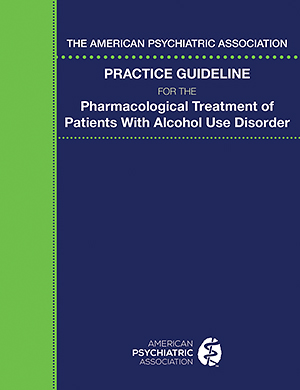Guideline Statement Summary
Assessment and Determination of Treatment Goals
APA recommends (1C) that the initial psychiatric evaluation of a patient with suspected alcohol use disorder include assessment of current and past use of tobacco and alcohol as well as any misuse of other substances, including prescribed or over-the-counter medications or supplements.
APA recommends (1C) that the initial psychiatric evaluation of a patient with suspected alcohol use disorder include a quantitative behavioral measure to detect the presence of alcohol misuse and assess its severity.
APA suggests (2C) that physiological biomarkers be used to identify persistently elevated levels of alcohol consumption as part of the initial evaluation of patients with alcohol use disorder or in the treatment of individuals who have an indication for ongoing monitoring of their alcohol use.
APA recommends (1C) that patients be assessed for co-occurring conditions (including substance use disorders, other psychiatric disorders, and other medical disorders) that may influence the selection of pharmacotherapy for alcohol use disorder.
APA suggests (2C) that the initial goals of treatment of alcohol use disorder (e.g., abstinence from alcohol use, reduction or moderation of alcohol use, other elements of harm reduction) be agreed on between the patient and clinician and that this agreement be documented in the medical record.
APA suggests (2C) that the initial goals of treatment of alcohol use disorder include discussion of the patient’s legal obligations (e.g., abstinence from alcohol use, monitoring of abstinence) and that this discussion be documented in the medical record.
APA suggests (2C) that the initial goals of treatment of alcohol use disorder include discussion of risks to self (e.g., physical health, occupational functioning, legal involvement) and others (e.g., impaired driving) from continued use of alcohol and that this discussion be documented in the medical record.
APA recommends (1C) that patients with alcohol use disorder have a documented comprehensive and person-centered treatment plan that includes evidence-based nonpharmacological and pharmacological treatments.
Selection of a Pharmacotherapy
APA recommends (1B) that naltrexone or acamprosate be offered to patients with moderate to severe alcohol use disorder who
have a goal of reducing alcohol consumption or achieving abstinence,
prefer pharmacotherapy or have not responded to nonpharmacological treatments alone, and
have no contraindications to the use of these medications.
APA suggests (2C) that disulfiram be offered to patients with moderate to severe alcohol use disorder who
have a goal of achieving abstinence,
prefer disulfiram or are intolerant to or have not responded to naltrexone and acamprosate,
are capable of understanding the risks of alcohol consumption while taking disulfiram, and
have no contraindications to the use of this medication.
APA suggests (2C) that topiramate or gabapentin be offered to patients with moderate to severe alcohol use disorder who
have a goal of reducing alcohol consumption or achieving abstinence,
prefer topiramate or gabapentin or are intolerant to or have not responded to naltrexone and acamprosate, and
have no contraindications to the use of these medications.
Recommendations Against Use of Specific Medications
APA recommends (1B) that antidepressant medications not be used for treatment of alcohol use disorder unless there is evidence of a co-occurring disorder for which an antidepressant is an indicated treatment.
APA recommends (1C) that in individuals with alcohol use disorder, benzodiazepines not be used unless treating acute alcohol withdrawal or unless a co-occurring disorder exists for which a benzodiazepine is an indicated treatment.
APA recommends (1C) that for pregnant or breastfeeding women with alcohol use disorder, pharmacological treatments not be used unless treating acute alcohol withdrawal with benzodiazepines or unless a co-occurring disorder exists that warrants pharmacological treatment.
APA recommends (1C) that acamprosate not be used by patients who have severe renal impairment.
APA recommends (1C) that for individuals with mild to moderate renal impairment, acamprosate not be used as a first-line treatment and, if used, the dose of acamprosate be reduced compared with recommended doses in individuals with normal renal function.
APA recommends (1C) that naltrexone not be used by patients who have acute hepatitis or hepatic failure.
APA recommends (1C) that naltrexone not be used as a treatment for alcohol use disorder by individuals who use opioids or who have an anticipated need for opioids.
Treatment of Alcohol Use Disorder and Co-occurring Opioid Use Disorder
APA recommends (1C) that in patients with alcohol use disorder and co-occurring opioid use disorder, naltrexone be prescribed to individuals who
wish to abstain from opioid use and either abstain from or reduce alcohol use and
are able to abstain from opioid use for a clinically appropriate time prior to naltrexone initiation.



